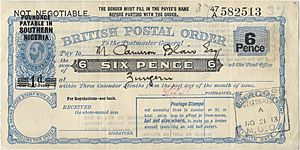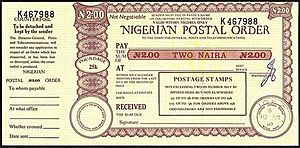Postal orders of Nigeria facts for kids
A postal order is like a special paper note you buy at a post office to send money to someone else. It's a safe way to send money without using cash. The first postal orders used in Nigeria were from the British. This was when Nigeria was under British rule. Later, Nigeria started printing its own postal orders. These first used the old Nigerian money (£, s, d), and then the newer Naira currency. In 2018, Nigeria stopped using postal orders. They switched to a cheaper electronic money order system instead.
Early Postal Orders in Nigeria
British postal orders started being used in Nigeria in 1907. You could buy them and get money for them at post offices. These British postal orders had special marks printed on them. These marks showed if they were for Northern or Southern Nigeria. It's very rare to find these old postal orders today. We know of only four that still exist from Southern Nigeria. None are known to have survived from Northern Nigeria.
Nigeria's Own Postal Orders
Nigeria became an independent country on October 1, 1960. After this, Nigeria began to print its own postal orders. These first postal orders used the Nigerian currency of pounds, shillings, and pence. Records show that a British company helped supply these first Nigerian postal orders.
New postal orders were printed in 1973. This was when Nigeria changed its money system. The country switched to the new decimal currency called the Naira. This made money calculations much simpler.
In 1987, a group called Nipost became in charge of postal order services in Nigeria. They were responsible for making sure people could send money using these orders. However, by late 2018, Nipost stopped using postal orders. They replaced them with a new electronic Money Order system. This new system is cheaper to use. You can get these electronic money orders at any post office. This makes it easier for people in both cities and rural areas to send money safely. This local service also works with an international money transfer system.




